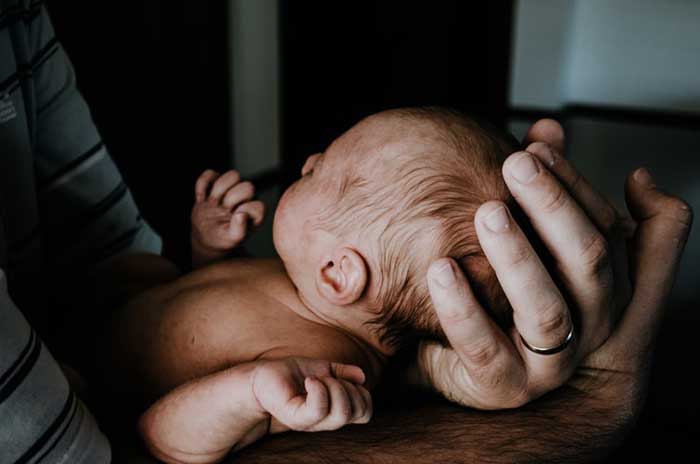What Is Flat Head Syndrome & How to Treat It?
There can occur a condition when an infant’s head shape shows a definite flat plane on the top, on the side or on the back. It is called a flat head syndrome, or, in the medical argot, plagiocephaly. The head of a baby with plagiocephaly looks out of symmetry, giving it a parallelogram shape if seen from above.
 The skull of a newborn baby remains relatively soft for about half a year after birth: flexible bones facilitate the birth process and provide suitable conditions for the growth of the brain.
The skull of a newborn baby remains relatively soft for about half a year after birth: flexible bones facilitate the birth process and provide suitable conditions for the growth of the brain.
Plagiocephaly doesn’t affect the development of the brain in any way, nor does it constitute a serious appearance issue. It needs a little rectifying, but no surgery is to be involved. By holding the infant in the right way and seeing that it sleeps in the right position you can improve the condition.
Why does it occur
The flattening of the skull is mostly caused by the wrong sleep position – babies spend so much time lying down that it may result in a certain area getting flattened. The problem may be aggravated through regular employing of sleeping devices like infant car and bouncy seats, carriers, strollers, and so on.
Since premature newborns’ heads are even softer, they are given to developing flattening spots more than other babies. Besides, they are often so fragile that they have to spend long stretches of time lying in the same position because their needs require them not to be disturbed unnecessarily.
Flat spots can begin forming on the head even before birth. The fetus’s skull can be pressed upon by a twin or by the pelvis. Actually, a birth of twins both displaying flat areas is quite a common occurrence.
When squeezed tightly by the womb the fetus can develop torticollis – one of the reasons of ending up with a flattened area. The infant who has torticollis has tightened muscles in the neck which makes it difficult for them to move their head. Consequently, when they lie down, they definitely prefer to retain the position of the head as long as possible – with a predictable result.
Symptoms of the condition
Actually the outward signs of the syndrome leap to the eye – the flattened area can be easily observed. It is usually not as overgrown with hair as other parts of the head. When looking at the head from above, the ear closer to the flat plane looks sort of pushed forward.
If the condition is well-pronounced, the flattening may cause the head to bulge on the other side and interfere with the evenness of the forehead. Caused by torticollis, it can bring about misshaping of the face, the neck and the lower jaw.
Diagnosis of the condition
It is enough for a professional to take one look at the infant’s head to know that there is plagiocephaly. To diagnose torticollis, the doctor will have to observe the movements of the child’s neck. It being an easy job, X-rays, tests, and tomography scans are not necessary for diagnosing.
After making a diagnosis, the doctor is likely to want to check on the baby a few times to markt he changes in the shape of his head.
How to treat the condition
Once you’ve discovered that the baby developed the flat head condition because of his sleeping habits, you can start correcting it at home.
Change the sleeping position
Of course we know that it’s preferable to put the baby on the bed on his back to avoid SIDS as far as it can be avoided, still the position had better be changed. Also, your baby can have his favorite position which he always assumes; mind you re-position him from time to time to alter the pressure on the head.
Using exercises
In cases of muscular torticollis, you can be recommended to employ special exercises designed to stretch and improve the motion of the neck. While they are definitely beneficial, you are not supposed to apply them without a professional prescription complete with directions.
Make a habit of holding the baby
As your baby is sleeping, pick him up and hold him in your arms, thereby reducing the time he lies on the bed resting his head upon surfaces such as strollers, car seats, bouncy seats and the like.
Introduce tummy lying
While the baby is awake, practice their lying on the stomach (with your eye on them, of course). It is a very useful practice in more than one way, strengthening the neck and providing improvement of head shaping. Incidentally, it gives the baby a new outlook and thus helps them evolve their exploration of the world around. Also, they have to push up with the arms giving exercise to muscles they will be using for crawling.
Working on the body
Since babies with flattened areas are also likely to suffer from torticollis, some kind of home exercise treatment is apt to be prescribed (probably with some other type of physical therapy). There are professional therapists who can show you exercises ensuring gradual stretching of the relevant muscles. They are mostly centered on moving the neck in the opposite direction to make the particular muscles grow longer consequently straightening the neck. These exercises are quite simple, nevertheless they require accuracy.
Using special helmets
In case the flat head condition is severe and resists rectifying after a couple of months, specially designed helmets can be prescribed. These helmets (or head bands) are most effective when applied at the age from 4 months to a year – the time when bones yield to correcting more easily and the development of the infant is on its peak. Considering the fact that few babies have to wear bands or helmets, you will need to ensure your doctor endorses to the treatment.
Resorting to surgery
Plagiocephaly doesn’t usually warrant surgery. But when you came to the stage when the sutures are closed and there is skull pressure that needs to be dealt with, you may have to end up requiring surgical intervention.
Expectations
Infants displaying flat head syndrome are highly likely to get over it. Growing, they acquire the habit of changing their sleep positions naturally more often than they used to in their first months, so their heads never stay in the same positions.
In the majority of cases, as soon as the baby learns to sit, his flat area condition is unlikely to get worse. As months go by and the skull develops, almost all cases of flattening are sure to wear off. It may occur that the head won’t ever get ideally symmetrical, yet the shape is sure to improve to a fairly decent extent.




